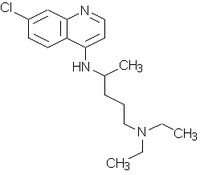Dias-Melicio, L. A.1; Calvi, S. A.2; Bordon, A. P.3; Acorci, M. J.4: Peraçoli, M. T. S.5; Scares. A. M. V. C.6
1,2,3,4,5,6 IB Unesp - Botucatu - Microbiologia e Imunologia
Introduction and Objectives: Cellular iron metabolism is of critical importance to the growth of several intracellular pathogens, including P. brasilienses (Pb). Chloroquine has been shown to raise endocytic and lysosomal pH of eukaryotic cells thereby interfering with normal iron metabolism in a variety of cell types. The objectives of this work were to study the effect of chloroquine on the evolution of experimental paracoccidioidomycosis by evaluating the organs viable fungi recovery, macrophage activation, cytokines production and transferrin receptor expression. Methods and Results: BALB/c male mice infected by i.v. route, with 10(6) yeasts of Pb 18 and daily treated with Chloroquine (40 and 80 mg/Kg) were sacrificed at 2, 4 and 8 weeks after infection, and evaluated by fungi recovery from lung, liver and spleen. Moreover, peritoneal macrophages were evaluated by H^sub 2^O^sub 2^ and NO 0production. TNF-α, 1L-6 and IL-10 levels by ELISA and transferrin receptor expression by flow citometry. In all periods Chlor 40 and 80 treated groups showed significant reduction of viable fungi recovery from lung, liver and spleen (more than 50%). At 2nd week the endogenous and PMA stimulated H^sub 2^O^sub 2^ production was higher in Chlor 40 group (meanisem 4,35±0,3nmol; 5,54±0,12, respectively) and Chlor 80 group (4.84±0.17; 4,8±0.11) when compared with only infected group (3±0,16: 4,65±0,2). At 4th week the endogenous H^sub 2^O^sub 2^ levels were higher in Chlor 80 (5.2±0,9) when compared with only infected group (3,54±0,3). At 2nd week, in Chlor 40 or 80 groups, endogenous NO levels were lower (7,93±3 mmol; 1,48±0,02) when compared with only infected group (31,8±0,7). NO levels released by LPS stimulated cells were similar in all groups. At 4th week, endogenous NO levels of infected and Chlor 40 groups decreased in relation to the first period ( 16,2±1,6; 1,9±0,2 respectively). At 8th week cells of all groups released similar endogenous NO levels in relation to the anterior period. However, LPS stimulated NO levels decreased in Chlor 40 and Chlor 80 groups at 4th and 8th weeks.The transferrin receptor expression was higher in Chlor 40 and Chlor 80 groups in all periods compared to the infected ones. The endogenous and LPS stimulated TNF-α levels of infected groups were low at the 2nd week (42±6 pg/mL, 113,4±2), with increase at 4th and 8th weeks (265±7, 470±11; 303±1,9, 543±23). However. Chlor 40 and Chlor 80 TNF-α levels were always lower than infected groups. Chlor 40 and Chlor 80 IL-6 levels at 2th (97,5±3; 70,9±3), 4th (195±10; 132±9) and 8th weeks (264±95; 176±38) were always lower than infected ones (1613+13; 19209±223; 1227±36 respectively). IL-10 levels were similar in all groups and periods. Conclusions: The results showed an important Chloroquine immunomodulatory role on the murine experimental paracoccidioidomycosis suggesting new insights for the mycosis therapy. Financial support: FAPESP.
Copyright Instituto de Medicina Tropical de Sao Paulo Oct 2005
Provided by ProQuest Information and Learning Company. All rights Reserved



